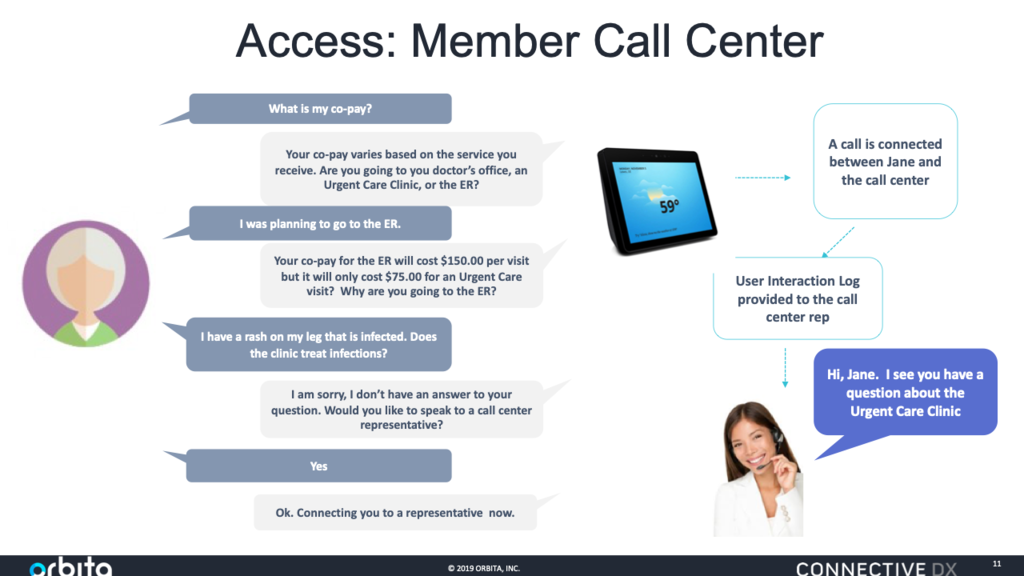How Health Systems Can Prepare for the Voice-First Future
// By Melanie Graham //
 Over the past 25 years, healthcare marketers have experienced several waves of digital disruption, from the adoption of the web to SEO, social media, and mobile devices.
Over the past 25 years, healthcare marketers have experienced several waves of digital disruption, from the adoption of the web to SEO, social media, and mobile devices.
The latest wave? Voice.
But voice assistants are not just a trendy marketing tool — they can provide many benefits for patients, health systems, and clinicians:
- Patients are more empowered in their healthcare and proactive about healthy practices, resulting in better outcomes.
- Health systems can provide better patient experience, increase patient engagement, improve outcomes, and boost staff productivity.
- Clinicians can improve their workflow and have better patient interactions and fewer administrative responsibilities.

Nate Treloar, president and chief operating officer, Orbita
“Voice tech and voice assistants are here to stay,” says Nate Treloar, president and COO of Orbita, a conversational AI platform. “The question is, how do we make it work for all the possible use cases in healthcare?”
Treloar recently gave a webinar covering some of these use cases, as well as best practices for healthcare organizations looking to implement a voice experience in their communication channels. The webinar, “Healthcare Content in a Voice-First World,” was co-presented by digital experience agency ConnectiveDX.
We recently caught up with Treloar to talk a little more about how healthcare content is evolving in a voice-first world, and how to tackle the new wave of voice technology.
The Changing Landscape
Virtual assistants are relatively new, and adoption is on the rise. Treloar highlighted a few key statistics to show how this digital disruption is making headway:
- Chatbot use is projected to grow 136 percent over the next 18 months (MediaPost, March 2019).
- By the year 2020, roughly 50 percent of all searches, or 1.2 trillion searches, will be done by voice (comScore).
- The number of U.S. homes with smart speakers has doubled in the past year and is predicted to grow another 25 percent by 2020 (MIT Technology Review).
And while healthcare may not evolve as quickly as other industries, the landscape has changed a lot in the past few years. Consumers are coming to expect more from their providers, and patients are open to adopting technology for their care. According to Accenture’s 2018 Consumer Survey on Digital Health:
- 61 percent of people surveyed would use an intelligent virtual health assistant that helps with estimated costs, scheduling appointments, bill payment, and explaining insurance coverage.
- 50 percent surveyed would use an intelligent virtual clinician that helps diagnose health issues and navigates to the right treatment options.
“We know that the interest in virtual healthcare assistants is on the rise and this study reinforces that,” Treloar says. “There is an opportunity here for healthcare organizations to adopt voice and chat interfaces as a complement to traditional digital experiences.”
Use Cases: Access and Delivery
Treloar discussed several use cases for voice assistants, each falling into one of two categories: access or delivery.
Access
In an access scenario, the voice assistant is helping the patient learn about a condition, ask basic questions, or get reminders about appointments.
For example, both Mayo Clinic and Cigna have developed Alexa skills that provide daily health tips or health answers from an FAQ-style database. Consumers can get answers to questions like “What is a deductible?” or “How should I treat a sunburn?”
Delivery
In a delivery scenario, a voice assistant could act as an in-facility communication tool, an alternative to the red emergency button in a hospital room. For example, the patient could say that he wants a glass of water, needs to use the toilet, or is curious about what’s on the dinner menu that evening.
Unlike that red button, a voice assistant can give additional context that allows the nursing staff to better triage patient needs.
Of course, the issue of patient security and HIPAA jumps into the minds of many healthcare providers when considering in-room listening devices.
“It’ll take some time, but [the in-facility assistants] are inevitable,” Treloar says. “People are starting to get their heads around it and it’s certainly an emerging use case.”
How Voice Is Different
If you’re considering building a voice experience, such as an Alexa skill, Treloar has a few key considerations, all of which challenge the traditional ways healthcare communicators think about content.
Knowledge vs. Content
Health systems that are starting to implement voice assistants or apps like an Alexa skill are likely using a third-party application that helps them create content for the experience.
“Question answering is the centerpiece of content management for a voice experience.”
Nate Treloar
OrbitaA knowledge base for the voice responses is a crucial part of the development, Treloar says. These knowledge bases are different from a typical content library because they are structured in a Q&A format.
“Question answering is the centerpiece of content management for a voice experience,” Treloar says.
The knowledge base is filled with facts that the voice assistant AI uses to answer questions. Each fact has a topic, a relationship, and an article. The knowledge base uses a tool called a knowledge graph to connect different topics and relationships with article answers.
For example, the voice assistant hears the question “What are the symptoms of diabetes?” and assigns a topic and relationship before finding the appropriate article answer.
- The topic is the subject of a question (“diabetes”).
- The relationship is an attribute of the topic (“symptoms”).
- The article contains the answer to the question about the relationship of the topic (“Symptoms of diabetes include…”).
Conversation vs. Navigation
But what if the user’s questions aren’t always clear? Remember that they won’t have access to a website navigation to find their answer.
“When you’re designing your voice experience, you’re designing the content in the context of a conversation,” Treloar says. “It’s crucial that you attach the right piece of content to the right question.”
For example, if someone asks “What are the symptoms of diabetes?” and then follows up with “What are the treatments?” the voice assistant AI should understand that the user is still talking about diabetes in the second question. Some AI platforms, including Orbita, include flow-modeling tools that you use to outline hypothetical questions and answers in the context of a conversation.
Voice vs. Text
Perhaps the biggest difference between a voice experience and web experience is how the article or answer is given to the user. With voice, the responses need to be short and “snackable,” not a 500-word blog post read over a smart speaker.
It’s also important to consider how the answer will sound when read by the voice assistant, including:
- Language, dialect, or accents
- Pronunciation, such as obscure drug names or conditions
- Tone, inflection, stress, speed, or rhythm (prosody)
These features can be coded into a response using a language called SSML (speech synthesis markup language). With tools like Orbita, you can add these speech synthesis features into each voice response using a WYHIWYG (what you hear is what you get) editor. Then, on the back end, the AI tool will build the response using SSML.
Treloar also notes it’s important to consider empathy in your voice experience (“I’m sorry you’re not feeling well”), as well as personalization with the user’s name or specific diagnosis.
“When you’re designing your voice experience, you’re designing the content in the context of a conversation. It’s crucial that you attach the right piece of content to the right question.”
Nate Treloar
OrbitaDesigning for a Voice-First Experience
Although tools are available to help health systems create voice assistants, Treloar underlines that developing a voice experience is about more than just copying and pasting existing content into a new platform. It’s about rethinking how that content is built and delivered.
“Voice is a fundamentally different platform because the user experience is unique,” Treloar says. “In the healthcare space especially, it’s about being thoughtful about how to design, manage, and curate content for a voice-first experience.”
Melanie Graham is a writer, editor, and digital strategist specializing in nonprofit and healthcare communications. She has a background in journalism, with experience in digital content marketing and social media management.


